Paper Menu >>
Journal Menu >>
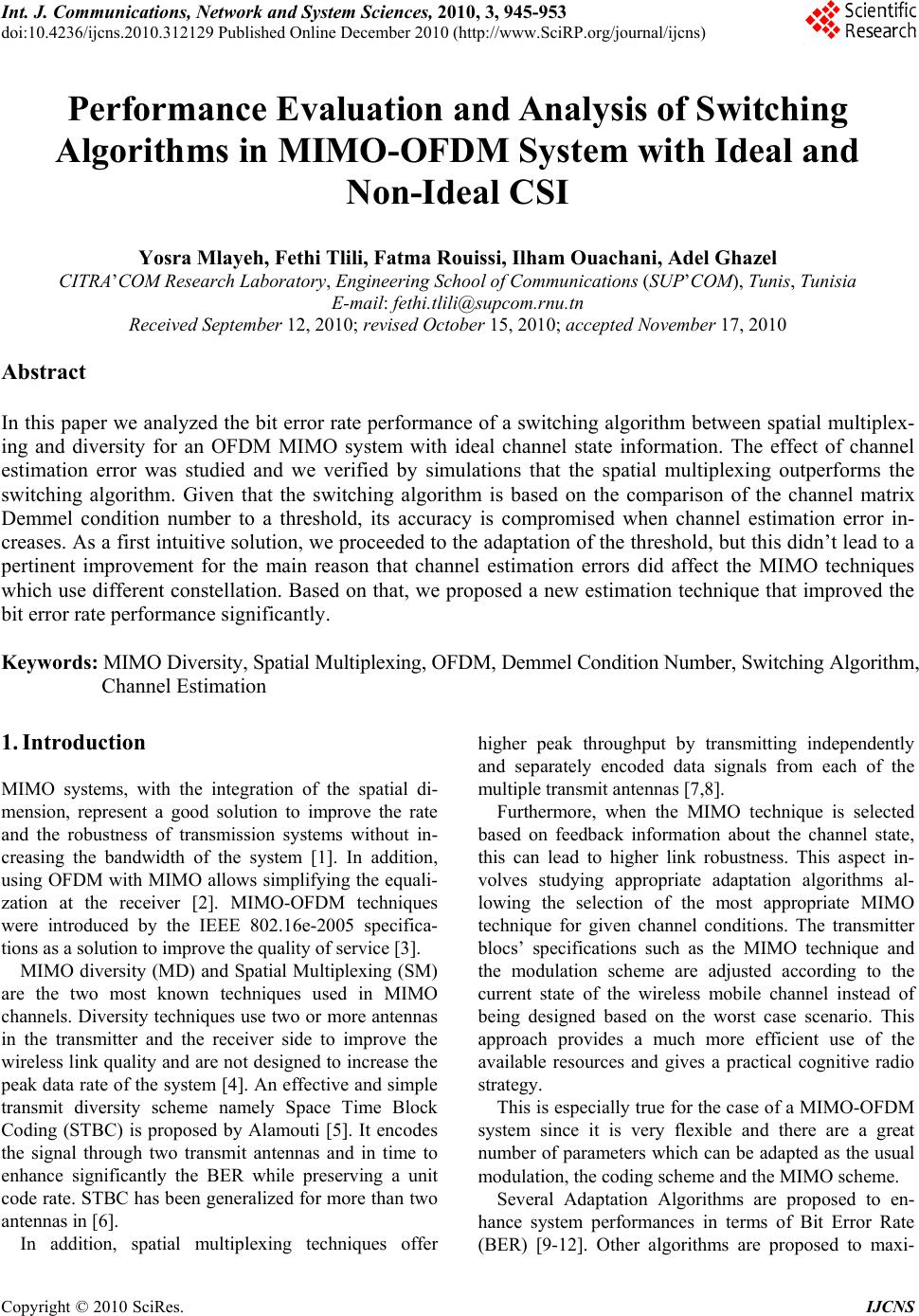 Int. J. Communications, Network and System Sciences, 2010, 3, 945-953 doi:10.4236/ijcns.2010.312129 Published Online December 2010 (http://www.SciRP.org/journal/ijcns) Copyright © 2010 SciRes. IJCNS Performance Evaluation and Analysis of Switching Algorithms in MIMO-OFDM System with Ideal and Non-Ideal CSI Yosra Mlayeh, Fethi Tlili, Fatma Rouissi, Ilham Ouachani, Adel Ghazel CITRA’COM Research Laboratory, Engineering School of Communications (SUP’COM), Tunis, Tunisia E-mail: fethi.tlili@supcom.rnu.tn Received September 12, 2010; revised October 15, 2010; accepted November 17, 2010 Abstract In this paper we analyzed the bit error rate performance of a switching algorithm between spatial multiplex- ing and diversity for an OFDM MIMO system with ideal channel state information. The effect of channel estimation error was studied and we verified by simulations that the spatial multiplexing outperforms the switching algorithm. Given that the switching algorithm is based on the comparison of the channel matrix Demmel condition number to a threshold, its accuracy is compromised when channel estimation error in- creases. As a first intuitive solution, we proceeded to the adaptation of the threshold, but this didn’t lead to a pertinent improvement for the main reason that channel estimation errors did affect the MIMO techniques which use different constellation. Based on that, we proposed a new estimation technique that improved the bit error rate performance significantly. Keywords: MIMO Diversity, Spatial Multiplexing, OFDM, Demmel Condition Number, Switching Algorithm, Channel Estimation 1. Introduction MIMO systems, with the integration of the spatial di- mension, represent a good solution to improve the rate and the robustness of transmission systems without in- creasing the bandwidth of the system [1]. In addition, using OFDM with MIMO allows simplifying the equali- zation at the receiver [2]. MIMO-OFDM techniques were introduced by the IEEE 802.16e-2005 specifica- tions as a solution to improve the quality of service [3]. MIMO diversity (MD) and Spatial Multiplexing (SM) are the two most known techniques used in MIMO channels. Diversity techniques use two or more antennas in the transmitter and the receiver side to improve the wireless link quality and are not designed to increase the peak data rate of the system [4]. An effective and simple transmit diversity scheme namely Space Time Block Coding (STBC) is proposed by Alamouti [5]. It encodes the signal through two transmit antennas and in time to enhance significantly the BER while preserving a unit code rate. STBC has been generalized for more than two antennas in [6]. In addition, spatial multiplexing techniques offer higher peak throughput by transmitting independently and separately encoded data signals from each of the multiple transmit antennas [7,8]. Furthermore, when the MIMO technique is selected based on feedback information about the channel state, this can lead to higher link robustness. This aspect in- volves studying appropriate adaptation algorithms al- lowing the selection of the most appropriate MIMO technique for given channel conditions. The transmitter blocs’ specifications such as the MIMO technique and the modulation scheme are adjusted according to the current state of the wireless mobile channel instead of being designed based on the worst case scenario. This approach provides a much more efficient use of the available resources and gives a practical cognitive radio strategy. This is especially true for the case of a MIMO-OFDM system since it is very flexible and there are a great number of parameters which can be adapted as the usual modulation, the coding scheme and the MIMO scheme. Several Adaptation Algorithms are proposed to en- hance system performances in terms of Bit Error Rate (BER) [9-12]. Other algorithms are proposed to maxi- 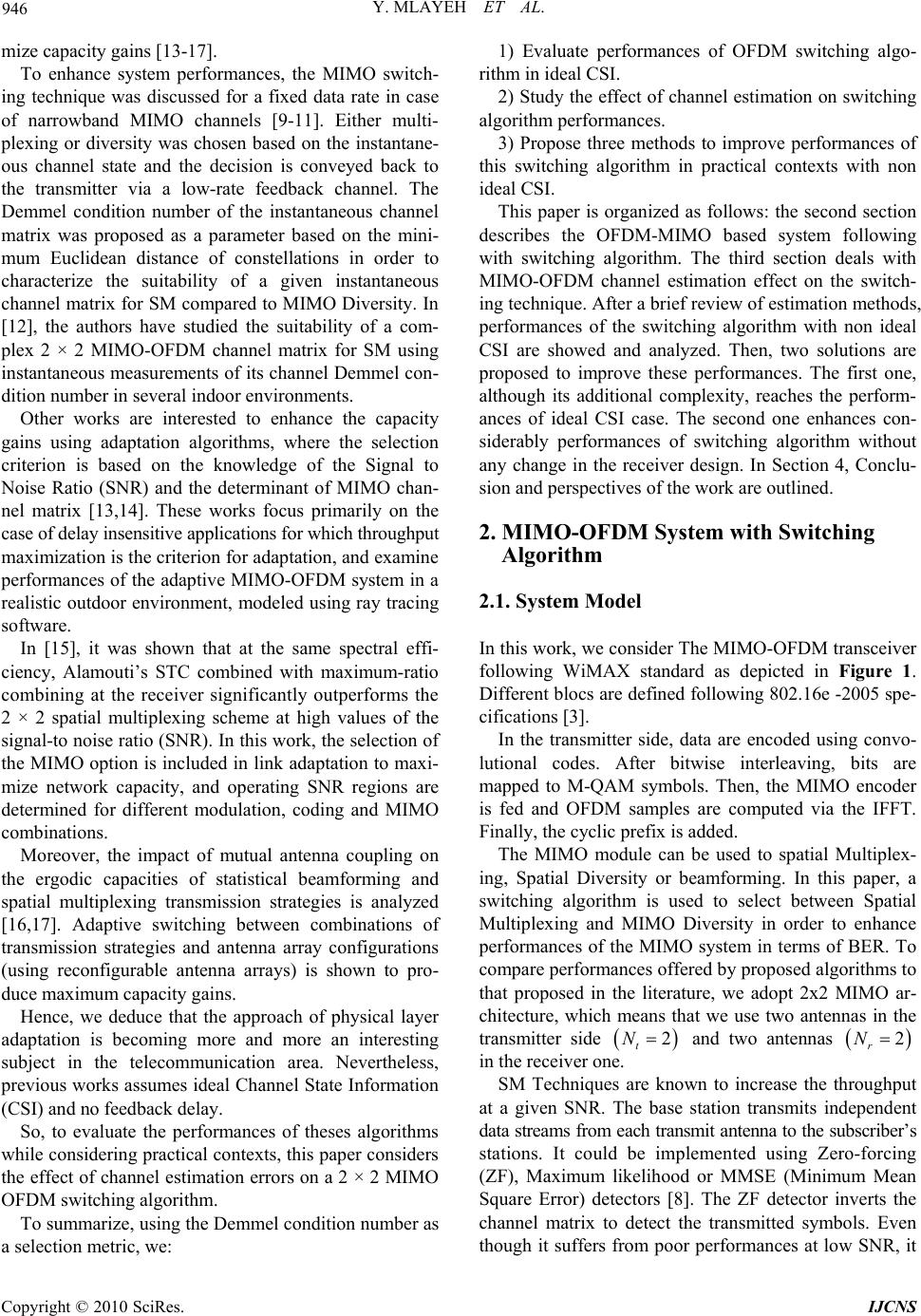 946 Y. MLAYEH ET AL. mize capacity gains [13-17]. To enhance system performances, the MIMO switch- ing technique was discussed for a fixed data rate in case of narrowband MIMO channels [9-11]. Either multi- plexing or diversity was chosen based on the instantane- ous channel state and the decision is conveyed back to the transmitter via a low-rate feedback channel. The Demmel condition number of the instantaneous channel matrix was proposed as a parameter based on the mini- mum Euclidean distance of constellations in order to characterize the suitability of a given instantaneous channel matrix for SM compared to MIMO Diversity. In [12], the authors have studied the suitability of a com- plex 2 × 2 MIMO-OFDM channel matrix for SM using instantaneous measurements of its channel Demmel con- dition number in several indoor environments. Other works are interested to enhance the capacity gains using adaptation algorithms, where the selection criterion is based on the knowledge of the Signal to Noise Ratio (SNR) and the determinant of MIMO chan- nel matrix [13,14]. These works focus primarily on the case of delay insensitive applications for which throughput maximization is the criterion for adaptation, and examine performances of the adaptive MIMO-OFDM system in a realistic outdoor environment, modeled using ray tracing software. In [15], it was shown that at the same spectral effi- ciency, Alamouti’s STC combined with maximum-ratio combining at the receiver significantly outperforms the 2 × 2 spatial multiplexing scheme at high values of the signal-to noise ratio (SNR). In this work, the selection of the MIMO option is included in link adaptation to maxi- mize network capacity, and operating SNR regions are determined for different modulation, coding and MIMO combinations. Moreover, the impact of mutual antenna coupling on the ergodic capacities of statistical beamforming and spatial multiplexing transmission strategies is analyzed [16,17]. Adaptive switching between combinations of transmission strategies and antenna array configurations (using reconfigurable antenna arrays) is shown to pro- duce maximum capacity gains. Hence, we deduce that the approach of physical layer adaptation is becoming more and more an interesting subject in the telecommunication area. Nevertheless, previous works assumes ideal Channel State Information (CSI) and no feedback delay. So, to evaluate the performances of theses algorithms while considering practical contexts, this paper considers the effect of channel estimation errors on a 2 × 2 MIMO OFDM switching algorithm. To summarize, using the Demmel condition number as a selection metric, we: 1) Evaluate performances of OFDM switching algo- rithm in ideal CSI. 2) Study the effect of channel estimation on switching algorithm performances. 3) Propose three methods to improve performances of this switching algorithm in practical contexts with non ideal CSI. This paper is organized as follows: the second section describes the OFDM-MIMO based system following with switching algorithm. The third section deals with MIMO-OFDM channel estimation effect on the switch- ing technique. After a brief review of estimation methods, performances of the switching algorithm with non ideal CSI are showed and analyzed. Then, two solutions are proposed to improve these performances. The first one, although its additional complexity, reaches the perform- ances of ideal CSI case. The second one enhances con- siderably performances of switching algorithm without any change in the receiver design. In Section 4, Conclu- sion and perspectives of the work are outlined. 2. MIMO-OFDM System with Switching Algorithm 2.1. System Model In this work, we consider The MIMO-OFDM transceiver following WiMAX standard as depicted in Figure 1. Different blocs are defined following 802.16e -2005 spe- cifications [3]. In the transmitter side, data are encoded using convo- lutional codes. After bitwise interleaving, bits are mapped to M-QAM symbols. Then, the MIMO encoder is fed and OFDM samples are computed via the IFFT. Finally, the cyclic prefix is added. The MIMO module can be used to spatial Multiplex- ing, Spatial Diversity or beamforming. In this paper, a switching algorithm is used to select between Spatial Multiplexing and MIMO Diversity in order to enhance performances of the MIMO system in terms of BER. To compare performances offered by proposed algorithms to that proposed in the literature, we adopt 2x2 MIMO ar- chitecture, which means that we use two antennas in the transmitter side 2 t N and two antennas 2 r N in the receiver one. SM Techniques are known to increase the throughput at a given SNR. The base station transmits independent data streams from each transmit antenna to the subscriber’s stations. It could be implemented using Zero-forcing (ZF), Maximum likelihood or MMSE (Minimum Mean Square Error) detectors [8]. The ZF detector inverts the channel matrix to detect the transmitted symbols. Even though it suffers from poor performances at low SNR, it Copyright © 2010 SciRes. IJCNS  Y. MLAYEH ET AL. Copyright © 2010 SciRes. IJCNS 947 b k k s Tx1 Bloc interleaving Mapping MIMO module: SM or MDIFFT Randomization and Convolutional coding IFFT P/S converter P/S converter Tx2 Rx1 Bloc desinterleav- ing DeMapping FFT FFT S/P converter S/P converter Rx2 CP insertion CP insertion CP removal CP removal Convolutional decoding and de-randomization MIMO module : SM or MD k b Figure 1. Block diagram of the MIMO- OFDM transceiver. is employed in this work as the detection scheme because it has a very small complexity and does not depend on the modulation type. MD uses two or more antennas in the transmitter and the receiver side to improve the wireless link quality. The main idea behind antenna diversity techniques is to produce different replicas of the transmitted signal to the receiver [5,6]. These replicas are sent over the propaga- tion channel. Due to this redundancy, the receiver can decode the transmitted signal even in fading conditions, as long as they all do not fade simultaneously. In this work, we use the Alamouti code as a Space Time Block Code (STBC). 2.2. Switching Between SM and MD Link adaptation plays a central role in regulating the use of radio resources. The idea behind switching algorithm is to dynamically adapt the MIMO technique and the modulation scheme to channel conditions in order to achieve the highest Bit Error Rate (BER) performances. Several channel metrics were proposed as selection crite- ria. The well-known metrics are Signal to Noise ratio, channel matrix determinant [13,14], the minimum Eucli- dean Distance [9,10] and the Demmel condition number [11,12]. In this work, the OFDM switching between the SM and the DM techniques is based on the Demmel condition number d K criterion. It can provide infor- mation about the invertibility of the channel which pro- vides knowledge about its suitability for use in either SM or MD operational modes [18]. The Demmel condition number for a random real or complex matrix H is de- fined in [19] as: min nF dn n K H H H (1) where Hn denotes the MIMO channel matrix of the nth subcarrier, min n H refers to the minimum singular value of Hn and refers to the Frobinüs norm. F The Demmel condition number measures how ill posed a given matrix is. Physically, in [7] it was shown that this metric provides a comparison between the minimum signal constellation distance needed to support SM and MD modes of operation for a given channel. Considering the expression of the Demmel condition number given by Equation (1), one sufficient condition that multiplexing will be better than diversity for a given channel matrix is given in [9] by: min, min, SMt dn M Dt d d KH, (2) where dmin,SMt and dmin,MDt are minimum Euclidean dis- tances at the transmitter side in case of SM and MD, re- spectively. The switching algorithm adds an extra processing in either the transmitter or the receiver. The decision is first computed by the receiver, for every subcarrier, then, it is sent back to the transmitter via a low rate feedback channel. Depending on the received decision vector, the transmitter will switch between the two MIMO tech- niques. To ensure that an overall rate of R bits per codeword is maintained, symbols are derived from a constellation with R bits per symbol when MD technique is chosen and with RNT bits per symbol when SM is chosen. Given that every subcarrier has its appropriate channel matrix and consequently its Demmel condition number, the decision is taken for every subcarrier. The switching algorithm will select the adequate MIMO technique in every subcarrier. 2.3. Performance Evaluation with Ideal CSI Performances in terms of BER of Demmel condition number was evaluated in case of narrowband channels in [9]. In order to evaluate these performances of switching 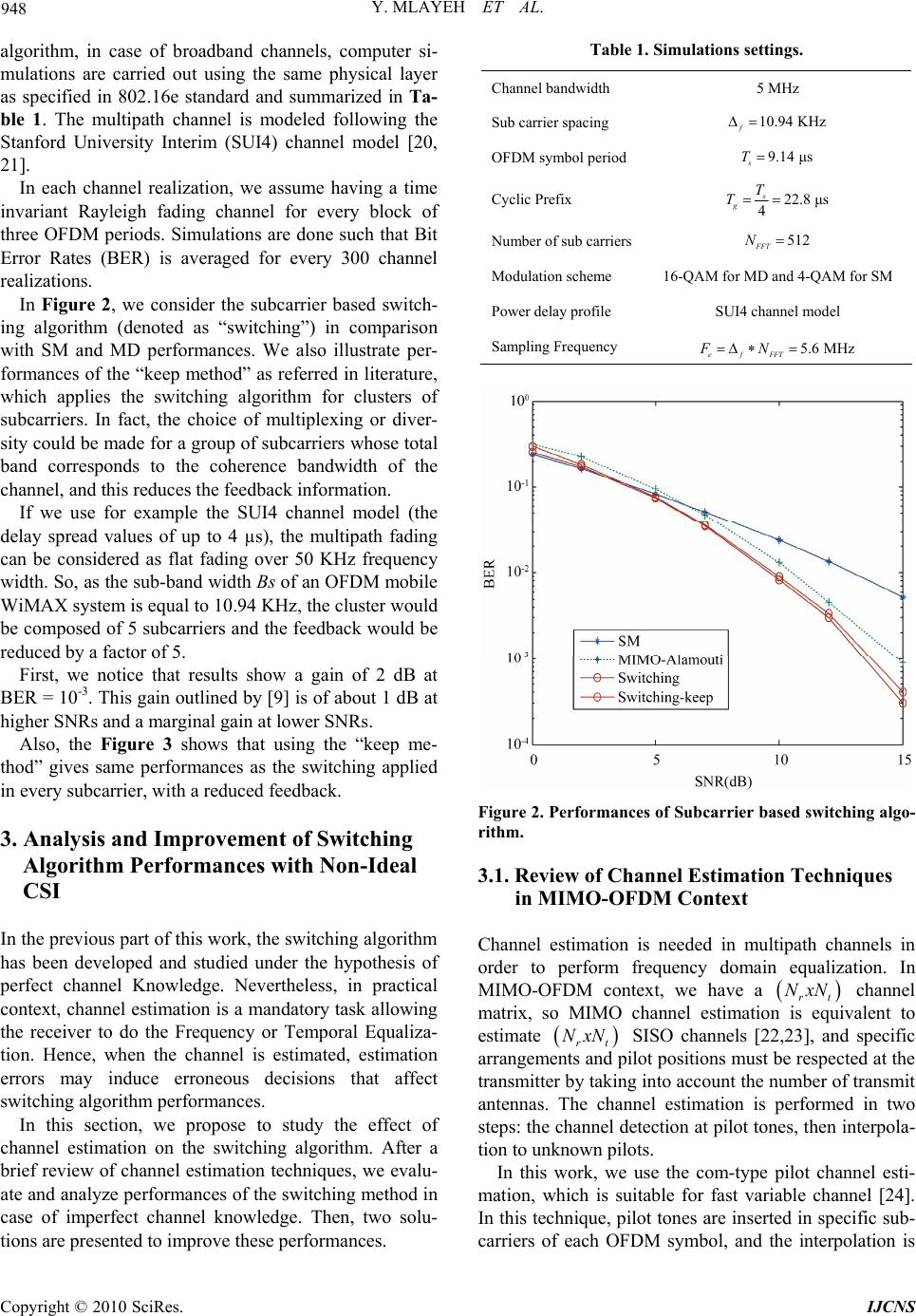 948 Y. MLAYEH ET AL. algorithm, in case of broadband channels, computer si- mulations are carried out using the same physical layer as specified in 802.16e standard and summarized in Ta- ble 1. The multipath channel is modeled following the Stanford University Interim (SUI4) channel model [20, 21]. In each channel realization, we assume having a time invariant Rayleigh fading channel for every block of three OFDM periods. Simulations are done such that Bit Error Rates (BER) is averaged for every 300 channel realizations. In Figure 2, we consider the subcarrier based switch- ing algorithm (denoted as “switching”) in comparison with SM and MD performances. We also illustrate per- formances of the “keep method” as referred in literature, which applies the switching algorithm for clusters of subcarriers. In fact, the choice of multiplexing or diver- sity could be made for a group of subcarriers whose total band corresponds to the coherence bandwidth of the channel, and this reduces the feedback information. If we use for example the SUI4 channel model (the delay spread values of up to 4 µs), the multipath fading can be considered as flat fading over 50 KHz frequency width. So, as the sub-band width Bs of an OFDM mobile WiMAX system is equal to 10.94 KHz, the cluster would be composed of 5 subcarriers and the feedback would be reduced by a factor of 5. First, we notice that results show a gain of 2 dB at BER = 10-3. This gain outlined by [9] is of about 1 dB at higher SNRs and a marginal gain at lower SNRs. Also, the Figure 3 shows that using the “keep me- thod” gives same performances as the switching applied in every subcarrier, with a reduced feedback. 3. Analysis and Improvement of Switching Algorithm Performances with Non-Ideal CSI In the previous part of this work, the switching algorithm has been developed and studied under the hypothesis of perfect channel Knowledge. Nevertheless, in practical context, channel estimation is a mandatory task allowing the receiver to do the Frequency or Temporal Equaliza- tion. Hence, when the channel is estimated, estimation errors may induce erroneous decisions that affect switching algorithm performances. In this section, we propose to study the effect of channel estimation on the switching algorithm. After a brief review of channel estimation techniques, we evalu- ate and analyze performances of the switching method in case of imperfect channel knowledge. Then, two solu- tions are presented to improve these performances. Table 1. Simulations settings. Channel bandwidth 5 MHz Sub carrier spacing 10.94 KHz f OFDM symbol period 9.14 μs s T Cyclic Prefix 22.8 μs 4 s g T T Number of sub carriers512 FFT N Modulation scheme 16-QAM for MD and 4-QAM for SM Power delay profile SUI4 channel model Sampling Frequency 5.6 MHz efFFT FN Figure 2. Performances of Subcarrier based switching algo- rithm. 3.1. Review of Channel Estimation Techniques in MIMO-OFDM Context Channel estimation is needed in multipath channels in order to perform frequency domain equalization. In MIMO-OFDM context, we have a channel matrix, so MIMO channel estimation is equivalent to estimate rt NxN rt NxN SISO channels [22,23], and specific arrangements and pilot positions must be respected at the transmitter by taking into account the number of transmit antennas. The channel estimation is performed in two steps: the channel detection at pilot tones, then interpola- tion to unknown pilots. In this work, we use the com-type pilot channel esti- mation, which is suitable for fast variable channel [24]. In this technique, pilot tones are inserted in specific sub- carriers of each OFDM symbl, and the interpolation is o Copyright © 2010 SciRes. IJCNS 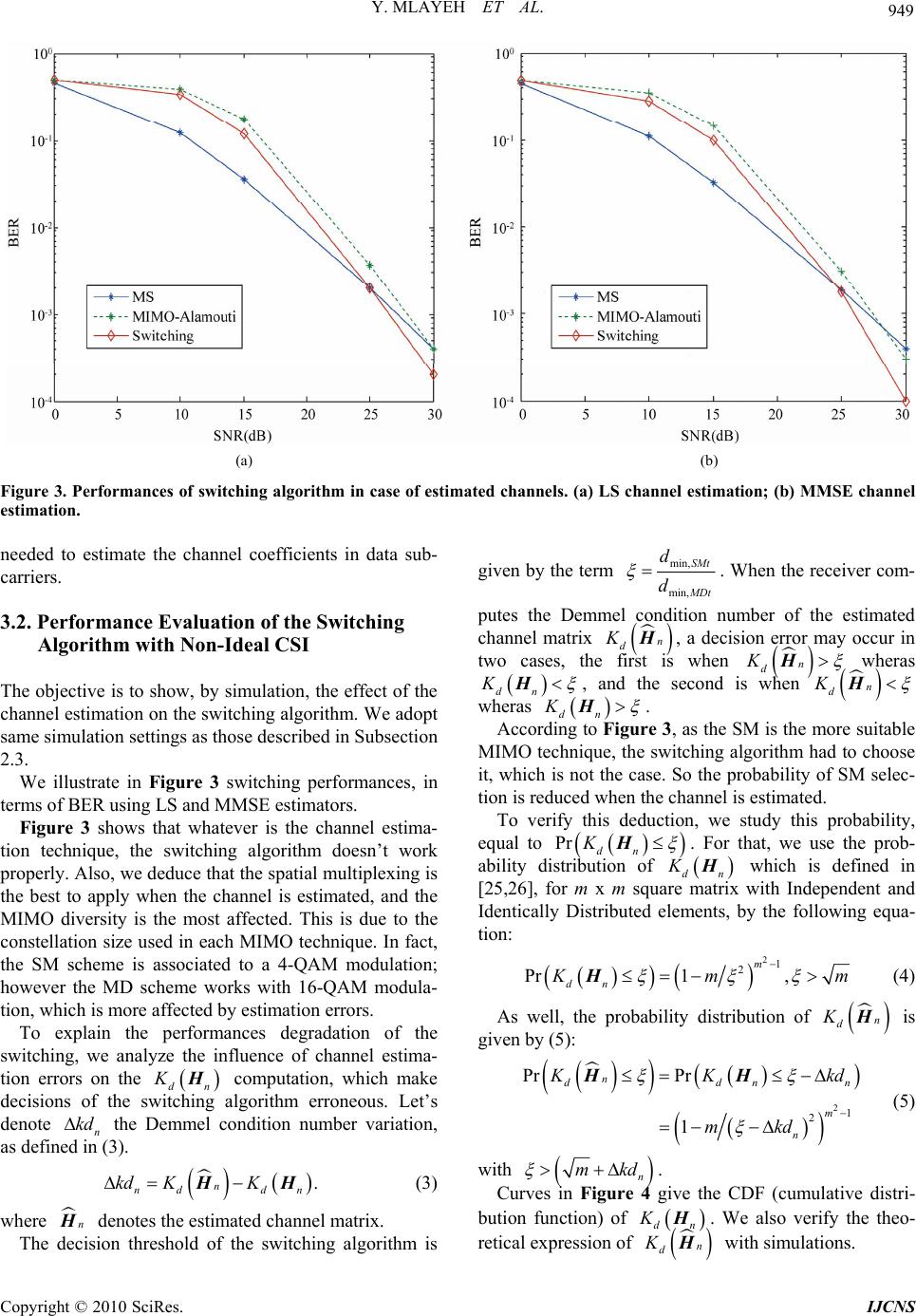 Y. MLAYEH ET AL. Copyright © 2010 SciRes. IJCNS 949 (a) (b) Figure 3. Performances of switching algorithm in case of estimated channels. (a) LS channel estimation; (b) MMSE channel estimation. needed to estimate the channel coefficients in data sub- carriers. given by the term min, min, SMt M Dt d d . When the receiver com- putes the Demmel condition number of the estimated channel matrix n d K H , a decision error may occur in two cases, the first is when n d K H wheras dn K H, and the second is when n d K H wheras 3.2. Performance Evaluation of the Switching Algorithm with Non-Ideal CSI The objective is to show, by simulation, the effect of the channel estimation on the switching algorithm. We adopt same simulation settings as those described in Subsection 2.3. dn K H. According to Figure 3, as the SM is the more suitable MIMO technique, the switching algorithm had to choose it, which is not the case. So the probability of SM selec- tion is reduced when the channel is estimated. We illustrate in Figure 3 switching performances, in terms of BER using LS and MMSE estimators. To verify this deduction, we study this probability, equal to Pr dn K HK. For that, we use the prob- ability distribution of dn Figure 3 shows that whatever is the channel estima- tion technique, the switching algorithm doesn’t work properly. Also, we deduce that the spatial multiplexing is the best to apply when the channel is estimated, and the MIMO diversity is the most affected. This is due to the constellation size used in each MIMO technique. In fact, the SM scheme is associated to a 4-QAM modulation; however the MD scheme works with 16-QAM modula- tion, which is more affected by estimation errors. H which is defined in [25,26], for m x m square matrix with Independent and Identically Distributed elements, by the following equa- tion: 21 2 Pr1 , m dn K mm H (4) As well, the probability distribution of n d K H is given by (5): To explain the performances degradation of the switching, we analyze the influence of channel estima- tion errors on the dn K H computation, which make decisions of the switching algorithm erroneous. Let’s denote n the Demmel condition number variation, as defined in (3). kd 21 2 Pr Pr 1 n ddn m n n K Kk mkd HHd (5) with n mkd . . n nd dn kd KK HH (3) Curves in Figure 4 give the CDF (cumulative distri- bution function) of dn K H . We also verify the theo- retical expression of n d K H with simulations. where n H denotes the estimated channel matrix. The decision threshold of the switching algorithm is 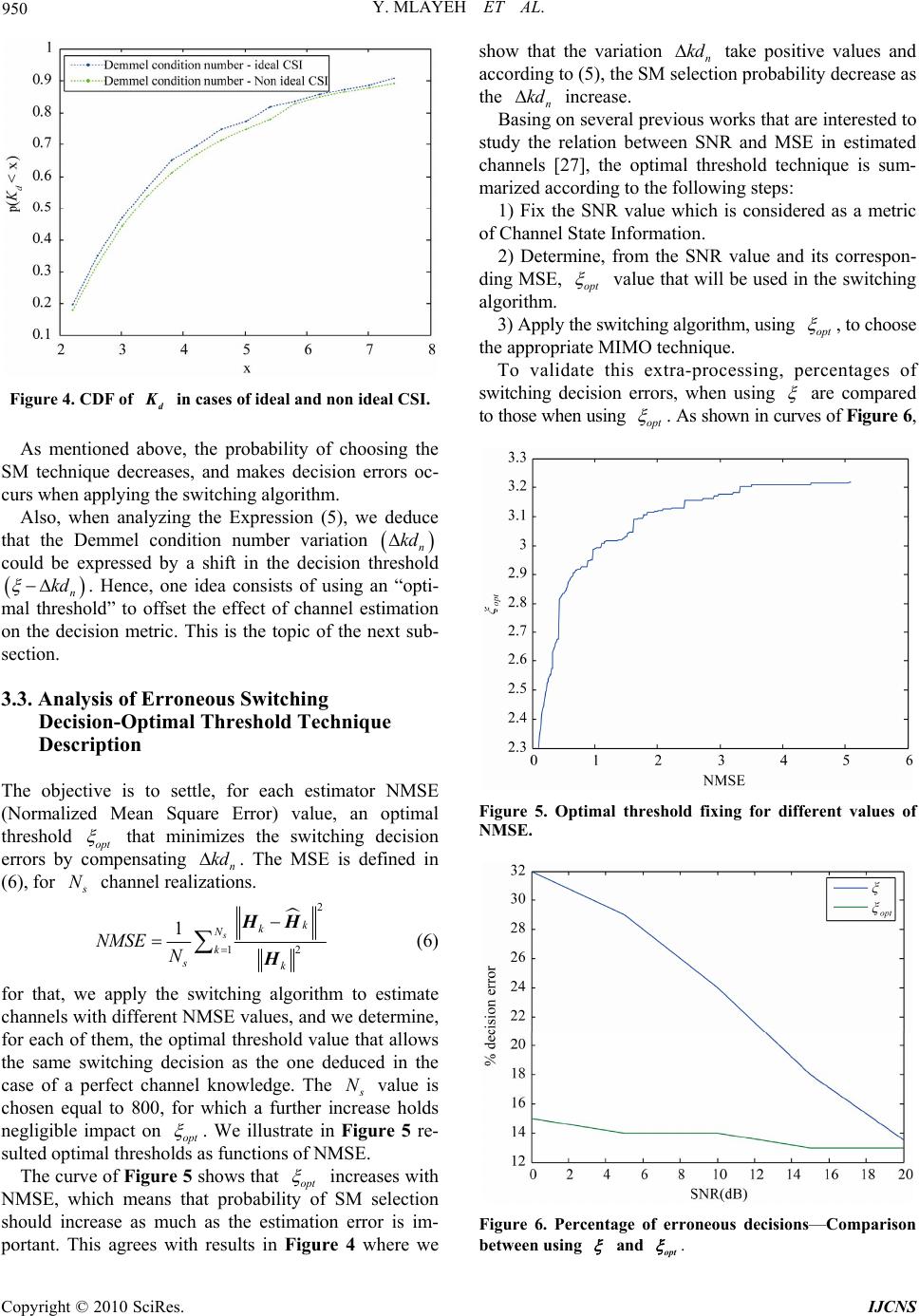 950 Y. MLAYEH ET AL. Figure 4. CDF of in cases of ideal and non ideal CSI. d K As mentioned above, the probability of choosing the SM technique decreases, and makes decision errors oc- curs when applying the switching algorithm. Also, when analyzing the Expression (5), we deduce that the Demmel condition number variation n kd could be expressed by a shift in the decision threshold . Hence, one idea consists of using an “opti- mal threshold” to offset the effect of channel estimation on the decision metric. This is the topic of the next sub- section. n kd 3.3. Analysis of Erroneous Switching Decision-Optimal Threshold Technique Description The objective is to settle, for each estimator NMSE (Normalized Mean Square Error) value, an optimal threshold opt that minimizes the switching decision errors by compensating n. The MSE is defined in (6), for kd s N channel realizations. 2 2 1 1sk k N k sk NMSE N HH H (6) for that, we apply the switching algorithm to estimate channels with different NMSE values, and we determine, for each of them, the optimal threshold value that allows the same switching decision as the one deduced in the case of a perfect channel knowledge. The s N value is chosen equal to 800, for which a further increase holds negligible impact on opt . We illustrate in Figure 5 re- sulted optimal thresholds as functions of NMSE. The curve of Figure 5 shows that opt increases with NMSE, which means that probability of SM selection should increase as much as the estimation error is im- portant. This agrees with results in Figure 4 where we show that the variation n kd take positive values and according to (5), the SM selection probability decrease as the n kd increase. Basing on several previous works that are interested to study the relation between SNR and MSE in estimated channels [27], the optimal threshold technique is sum- marized according to the following steps: 1) Fix the SNR value which is considered as a metric of Channel State Information. 2) Determine, from the SNR value and its correspon- ding MSE, opt value that will be used in the switching algorithm. 3) Apply the switching algorithm, using opt , to choose the appropriate MIMO technique. To validate this extra-processing, percentages of switching decision errors, when using are compared to those when using opt . As shown in curves of Figure 6, Figure 5. Optimal threshold fixing for different values of NMSE. Figure 6. Percentage of erroneous decisions—Comparison between using and opt . Copyright © 2010 SciRes. IJCNS  Y. MLAYEH ET AL. 951 using optimal threshold improve considerably the switch- ing decision. To study the impact of the decision on performances of switching module in terms of BER, we evaluate per- formances of switching algorithm with threshold adapta- tion compared to those using fixed threshold. The curves of Figure 7 show that the amelioration added by adaptation process is poor and the switching technique performances are no longer degraded com- pared to Spatial Multiplexing. So, we conclude that channel estimation errors will not create decision errors only and that the switching algorithm degradation is also due to the effect of these estimation errors on two MIMO modes at the time of equalization. This is due to the de- pendence of channel estimation error on M-QAM con- stellation in Rayleigh fading channels [28,29]. In fact, estimation errors are as more important as the constella- tion is greater. The modulation order used for every technique (4-QAM and 16-QAM) exhibits an error floor for low values of SNR (< 25 dB) and this has an impact on performances of switching algorithm. The blue curves show that in SNR range [0-25], the SM technique gives better performances than switching algorithm. Neverthe- less, for high values of SNR, The switching algorithm works properly. Hence, developing a robust channel es- timation method is essential to exploit performances of- fered by the advanced MIMO algorithms as the switch- ing algorithm. 3.4. Proposal Solutions to Improve the Switching Algorithm with Non-Ideal CSI In this subsection, we describe two solutions to reduce Figure 7. Performances of the switching algorithm using opt in case of estimated channels. estimation errors in order to improve the switching algo- rithm performances even in low SNR. The first technique is to develop a robust method of channel estimation; the second is to use a reduced constellation in the estimation by describing a novel channel estimation process. 3.4.1. Robus t Channel Estimati on In [30], we have developed an IFFT/FFT LS estimation channel method based only on the knowledge of the power delay profile of the channel. It consists of adding an extra IFFT/FFT processing to better estimate channel coefficients. This method is summarized according to the following steps [30]: Apply the conventional LS estimator to determine a first approximation of channel frequency re- sponse coefficients. Convert LS estimated coefficients into the time domain, using the IFFT transform. The result of this step is impulse response coefficients ˆn h for n = 0,, (N – 1) where N is the subcarrier number. Exploit the information providing by the path delay which is the number L and positions of taps. So, corresponding impulse response coefficients are kept, the remaining (N – L) non considered coeffi- cients will be set to zero. This is conveyed by (6). 01 1 ˆif in,,, 0else nL nhnlll h (7) where 01 1 ,, , L ll l is the set of taps index. Apply the FFT transform to the new impulse re- sponse h to obtain frequency response coeffi- cients n H for 0,1, ,1nN . 3.4.2. New Switching Process In Subsection 3.3, we’ve shown that the switching algo- rithm performances degrade because of different con- stellation size used by the two MIMO modes. So, the idea of this part of the work consists of using a small constellation size to improve the channel estimation and so the switching algorithm. For that, we propose to apply a training process based on the transmission of two OFDM symbols, during one OFDM symbol period, using the 4-QAM modulation with SM as a MIMO scheme. By assuming that the channel is constant over three OFDM symbol periods, the information provided after this training period is ex- ploited to: Compute the Demmel condition number to have knowledge about the “goodness” of every subcar- rier for use in SM or MD. The decision vector will be applied to do the switching in the next two OFDM symbol periods. Apply the estimated channel coefficients in equa- Copyright © 2010 SciRes. IJCNS 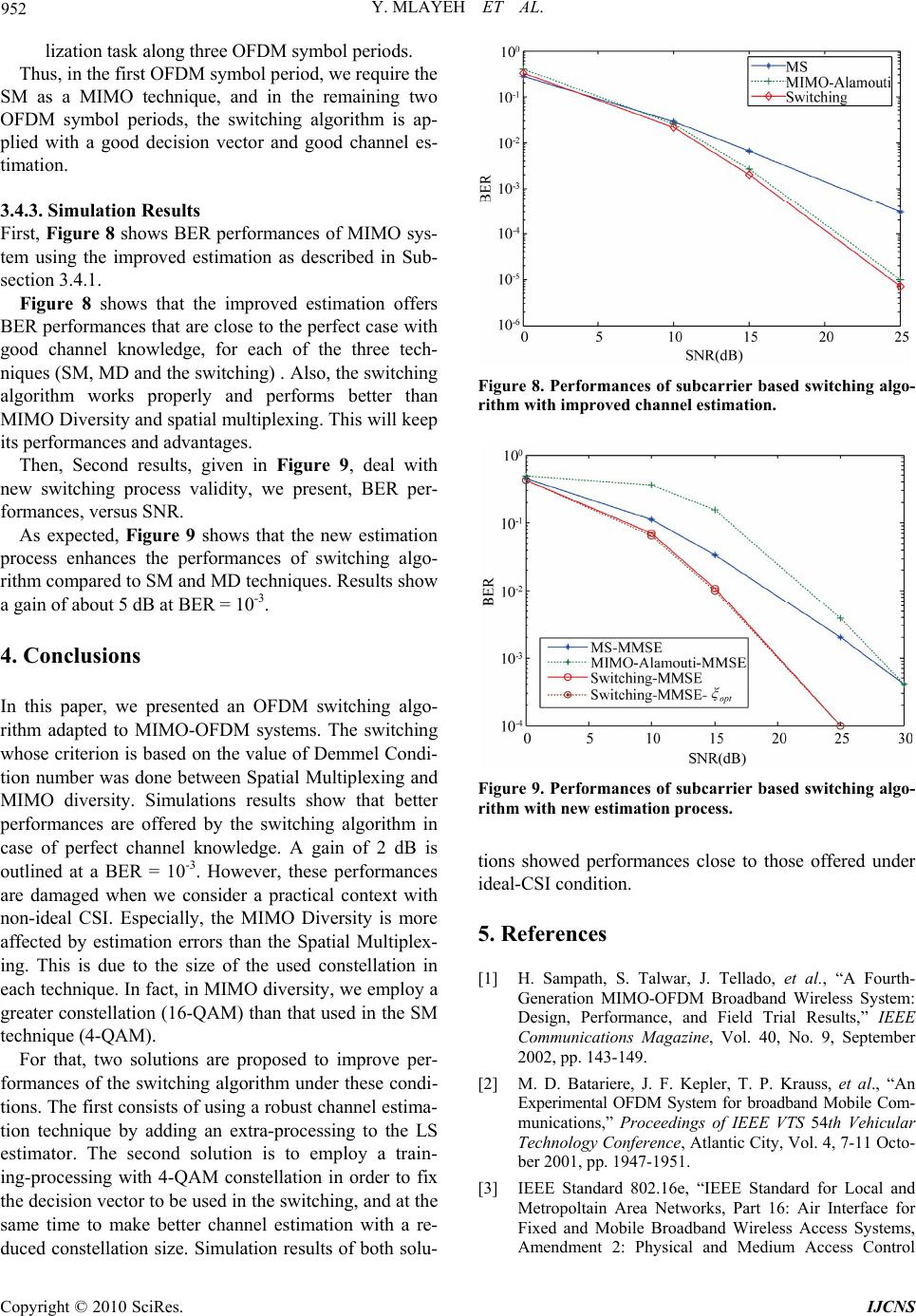 952 Y. MLAYEH ET AL. lization task along three OFDM symbol periods. Thus, in the first OFDM symbol period, we require the SM as a MIMO technique, and in the remaining two OFDM symbol periods, the switching algorithm is ap- plied with a good decision vector and good channel es- timation. 3.4.3. Simulation Results First, Figure 8 shows BER performances of MIMO sys- tem using the improved estimation as described in Sub- section 3.4.1. Figure 8 shows that the improved estimation offers BER performances that are close to the perfect case with good channel knowledge, for each of the three tech- niques (SM, MD and the switching) . Also, the switching algorithm works properly and performs better than MIMO Diversity and spatial multiplexing. This will keep its performances and advantages. Then, Second results, given in Figure 9, deal with new switching process validity, we present, BER per- formances, versus SNR. As expected, Figure 9 shows that the new estimation process enhances the performances of switching algo- rithm compared to SM and MD techniques. Results show a gain of about 5 dB at BER = 10-3. 4. Conclusions In this paper, we presented an OFDM switching algo- rithm adapted to MIMO-OFDM systems. The switching whose criterion is based on the value of Demmel Condi- tion number was done between Spatial Multiplexing and MIMO diversity. Simulations results show that better performances are offered by the switching algorithm in case of perfect channel knowledge. A gain of 2 dB is outlined at a BER = 10-3. However, these performances are damaged when we consider a practical context with non-ideal CSI. Especially, the MIMO Diversity is more affected by estimation errors than the Spatial Multiplex- ing. This is due to the size of the used constellation in each technique. In fact, in MIMO diversity, we employ a greater constellation (16-QAM) than that used in the SM technique (4-QAM). For that, two solutions are proposed to improve per- formances of the switching algorithm under these condi- tions. The first consists of using a robust channel estima- tion technique by adding an extra-processing to the LS estimator. The second solution is to employ a train- ing-processing with 4-QAM constellation in order to fix the decision vector to be used in the switching, and at the same time to make better channel estimation with a re- duced constellation size. Simulation results of both solu- Figure 8. Performances of subcarrier based switching algo- rithm with improved channel estimation. Figure 9. Performances of subcarrier based switching algo- rithm with new estimation process. tions showed performances close to those offered under ideal-CSI condition. 5. References [1] H. Sampath, S. Talwar, J. Tellado, et al., “A Fourth- Generation MIMO-OFDM Broadband Wireless System: Design, Performance, and Field Trial Results,” IEEE Communications Magazine, Vol. 40, No. 9, September 2002, pp. 143-149. [2] M. D. Batariere, J. F. Kepler, T. P. Krauss, et al., “An Experimental OFDM System for broadband Mobile Com- munications,” Proceedings of IEEE VTS 54th Vehicular Technology Conference, Atlantic City, Vol. 4, 7-11 Octo- ber 2001, pp. 1947-1951. [3] IEEE Standard 802.16e, “IEEE Standard for Local and Metropoltain Area Networks, Part 16: Air Interface for Fixed and Mobile Broadband Wireless Access Systems, Amendment 2: Physical and Medium Access Control Copyright © 2010 SciRes. IJCNS 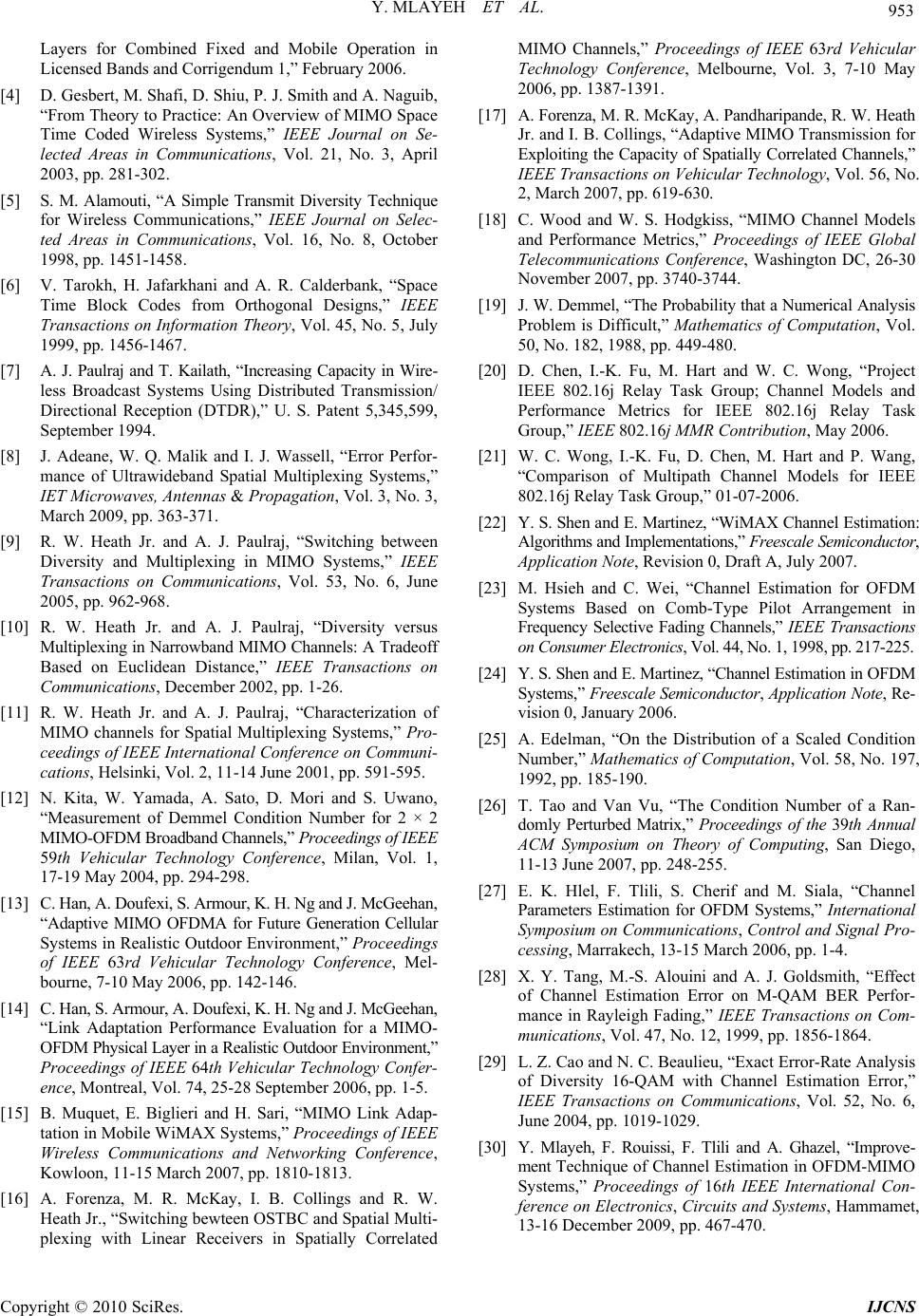 Y. MLAYEH ET AL. Copyright © 2010 SciRes. IJCNS 953 Layers for Combined Fixed and Mobile Operation in Licensed Bands and Corrigendum 1,” February 2006. [4] D. Gesbert, M. Shafi, D. Shiu, P. J. Smith and A. Naguib, “From Theory to Practice: An Overview of MIMO Space Time Coded Wireless Systems,” IEEE Journal on Se- lected Areas in Communications, Vol. 21, No. 3, April 2003, pp. 281-302. [5] S. M. Alamouti, “A Simple Transmit Diversity Technique for Wireless Communications,” IEEE Journal on Selec- ted Areas in Communications, Vol. 16, No. 8, October 1998, pp. 1451-1458. [6] V. Tarokh, H. Jafarkhani and A. R. Calderbank, “Space Time Block Codes from Orthogonal Designs,” IEEE Transactions on Information Theory, Vol. 45, No. 5, July 1999, pp. 1456-1467. [7] A. J. Paulraj and T. Kailath, “Increasing Capacity in Wire- less Broadcast Systems Using Distributed Transmission/ Directional Reception (DTDR),” U. S. Patent 5,345,599, September 1994. [8] J. Adeane, W. Q. Malik and I. J. Wassell, “Error Perfor- mance of Ultrawideband Spatial Multiplexing Systems,” IET Microwaves, Antennas & Propagation, Vol. 3, No. 3, March 2009, pp. 363-371. [9] R. W. Heath Jr. and A. J. Paulraj, “Switching between Diversity and Multiplexing in MIMO Systems,” IEEE Transactions on Communications, Vol. 53, No. 6, June 2005, pp. 962-968. [10] R. W. Heath Jr. and A. J. Paulraj, “Diversity versus Multiplexing in Narrowband MIMO Channels: A Tradeoff Based on Euclidean Distance,” IEEE Transactions on Communications, December 2002, pp. 1-26. [11] R. W. Heath Jr. and A. J. Paulraj, “Characterization of MIMO channels for Spatial Multiplexing Systems,” Pro- ceedings of IEEE International Conference on Communi- cations, Helsinki, Vol. 2, 11-14 June 2001, pp. 591-595. [12] N. Kita, W. Yamada, A. Sato, D. Mori and S. Uwano, “Measurement of Demmel Condition Number for 2 × 2 MIMO-OFDM Broadband Channels,” Proceedings of IEEE 59th Vehicular Technology Conference, Milan, Vol. 1, 17-19 May 2004, pp. 294-298. [13] C. Han, A. Doufexi, S. Armour, K. H. Ng and J. McGeehan, “Adaptive MIMO OFDMA for Future Generation Cellular Systems in Realistic Outdoor Environment,” Proceedings of IEEE 63rd Vehicular Technology Conference, Mel- bourne, 7-10 May 2006, pp. 142-146. [14] C. Han, S. Armour, A. Doufexi, K. H. Ng and J. McGeehan, “Link Adaptation Performance Evaluation for a MIMO- OFDM Physical Layer in a Realistic Outdoor Environment,” Proceedings of IEEE 64th Vehicular Technology Confer- ence, Montreal, Vol. 74, 25-28 September 2006, pp. 1-5. [15] B. Muquet, E. Biglieri and H. Sari, “MIMO Link Adap- tation in Mobile WiMAX Systems,” Proceedings of IEEE Wireless Communications and Networking Conference, Kowloon, 11-15 March 2007, pp. 1810-1813. [16] A. Forenza, M. R. McKay, I. B. Collings and R. W. Heath Jr., “Switching bewteen OSTBC and Spatial Multi- plexing with Linear Receivers in Spatially Correlated MIMO Channels,” Proceedings of IEEE 63rd Vehicular Technology Conference, Melbourne, Vol. 3, 7-10 May 2006, pp. 1387-1391. [17] A. Forenza, M. R. McKay, A. Pandharipande, R. W. Heath Jr. and I. B. Collings, “Adaptive MIMO Transmission for Exploiting the Capacity of Spatially Correlated Channels,” IEEE Transactions on Vehicular Technology, Vol. 56, No. 2, March 2007, pp. 619-630. [18] C. Wood and W. S. Hodgkiss, “MIMO Channel Models and Performance Metrics,” Proceedings of IEEE Global Telecommunications Conference, Washington DC, 26-30 November 2007, pp. 3740-3744. [19] J. W. Demmel, “The Probability that a Numerical Analysis Problem is Difficult,” Mathematics of Computation, Vol. 50, No. 182, 1988, pp. 449-480. [20] D. Chen, I.-K. Fu, M. Hart and W. C. Wong, “Project IEEE 802.16j Relay Task Group; Channel Models and Performance Metrics for IEEE 802.16j Relay Task Group,” IEEE 802.16j MMR Contribution, May 2006. [21] W. C. Wong, I.-K. Fu, D. Chen, M. Hart and P. Wang, “Comparison of Multipath Channel Models for IEEE 802.16j Relay Task Group,” 01-07-2006. [22] Y. S. Shen and E. Martinez, “WiMAX Channel Estimation: Algorithms and Implementations,” Freescale Semiconductor, Application Note, Revision 0, Draft A, July 2007. [23] M. Hsieh and C. Wei, “Channel Estimation for OFDM Systems Based on Comb-Type Pilot Arrangement in Frequency Selective Fading Channels,” IEEE Transactions on Consumer Electron ics, Vol. 44, No. 1, 1998, pp. 217-225. [24] Y. S. Shen and E. Martinez, “Channel Estimation in OFDM Systems,” Freescale Semiconductor, Applic ation Note, Re- vision 0, January 2006. [25] A. Edelman, “On the Distribution of a Scaled Condition Number,” Mathematics of Computation, Vol. 58, No. 197, 1992, pp. 185-190. [26] T. Tao and Van Vu, “The Condition Number of a Ran- domly Perturbed Matrix,” Proceedings of the 39th Annual ACM Symposium on Theory of Computing, San Diego, 11-13 June 2007, pp. 248-255. [27] E. K. Hlel, F. Tlili, S. Cherif and M. Siala, “Channel Parameters Estimation for OFDM Systems,” International Symposium on Communications, Control and Signal Pro- cessing, Marrakech, 13-15 March 2006, pp. 1-4. [28] X. Y. Tang, M.-S. Alouini and A. J. Goldsmith, “Effect of Channel Estimation Error on M-QAM BER Perfor- mance in Rayleigh Fading,” IEEE Transactions on Com- munications, Vol. 47, No. 12, 1999, pp. 1856-1864. [29] L. Z. Cao and N. C. Beaulieu, “Exact Error-Rate Analysis of Diversity 16-QAM with Channel Estimation Error,” IEEE Transactions on Communications, Vol. 52, No. 6, June 2004, pp. 1019-1029. [30] Y. Mlayeh, F. Rouissi, F. Tlili and A. Ghazel, “Improve- ment Technique of Channel Estimation in OFDM-MIMO Systems,” Proceedings of 16th IEEE International Con- ference on Electronics, Circuits and Systems, Hammamet, 13-16 December 2009, pp. 467-470. |

